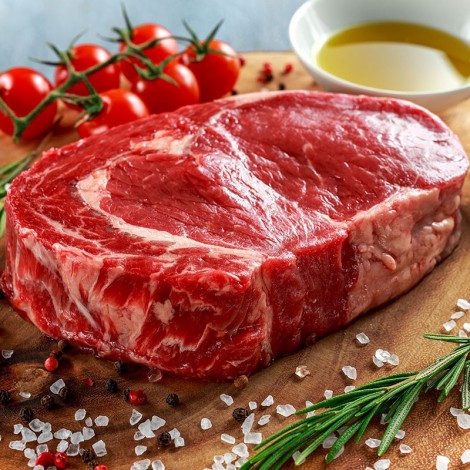- Origin: Australia
- Quality assurance: Wagyu MSA 6+
Filter By
Ribeye steak
- Origin: USA
- Quality assurance: USDA CHOICE
- Origin: Poland
- Origin: USA
- Quality assurance: USDA PRIME
- Origin: Poland
- Origin: Argentina
- Quality assurance: Argentine Quality Beef
- Origin: Namibia
- Quality assurance: BMS 5-7
- Origin: Japan
- Quality assurance: Wagyu A5 BMS 8
- Origin: Spain
- Quality assurance: BIO
- Origin: Japan
- Quality assurance: Wagyu A4- BMS 5
- Origin: Australia
- Quality assurance: USDA CHOICE
- Origin: Poland
- Origin: Japan
- Quality assurance: Wagyu A5+ BMS 10
- Origin: Namibia
- Origin: Uruguay
From what element in the carcass does the rib eye steak originate
Beef entrée steak, or Rib eye steak comes from the front part of the back, the longissimus dorsi (Latin for longest) muscle. This element runs along both sides of the spine surrounding a "cage" of ribs from the outside. This is very important because the dorsal muscles located there do almost no motor work during the movement of the animal. As a result, they are among the most fragile and delicate muscles in the carcass.
How else do we call it
As one of the best steaks, it has many names and so we will most often meet it under the name Ribeye steak, but it also occurs under names such as Delmonico Steak, Spencer steak, Schotch steak, Prime steak, Saragota steak and Beauty steak. In French-style restaurants, it may also be called L'Entrecôte or Entrecôte.
What are the types
It also comes in several variants. The most popular is simply boneless steak. Another variant is a steak with a short rib bone, which we usually call Cowboy steak or Cote de boeuf. A steak with a long rib bone is Tomahowk. One thing is certain, in each of these versions, rib eye steaks will taste great if the meat is of high quality.
Why is it so tender and tasty
Boneless or bone-in are considered the best meat for steaks. They owe this mainly to their abundant marbling, and it is known that the higher the marbling, the higher the quality of ours. The distinctive, meaty flavor actually comes from the fat. Of course, it is also of great importance that the entrecote belongs to the group of non-motor muscles. In order for it to be perfect, it must additionally come from young cattle of appropriate meat breeds, fed with natural fodder, bred stress-free. Meat after slaughter must be seasoned for a long time. In our store, we select beef so that it meets all the criteria that guarantee perfect quality and culinary satisfaction of our customers.Is ribeye on the bone better than boneless
The truth is, it's purely a matter of preference. Because in both cases it is primarily about the highest quality of meat, the presence of bones will no longer be just an addition. Of course, many gourmets are able to discuss this topic for hours, claiming that meat with more bones is tastier and has more aroma. There is some truth to this, but with really high-quality meat, both options are the most beneficial choice, and the bone can only enrich the culinary palette of flavors.
How best to prepare it
There are countless ways to prepare beef entrecote steaks. It is perfect for frying and grilling. On our blog you will find numerous recipes, but also information on how to achieve your preferred level of doneness, marinating tips and other practical advice. In our opinion, good quality will be the best without marinating (only salt and pepper) and medium or medium rare.
What wines are best to pair with it
Typically, very marbled steaks such as rib eye steaks go best with full-bodied, very expressive wines such as Cabernet Sauyvignon. For those who do not like such intense wines, we recommend the lighter Zinfandel wine, Malbec from Chile or Argentina or Pinot Noir. As always, everything depends on our individual taste.


















